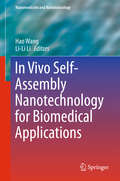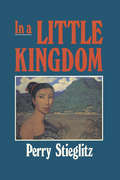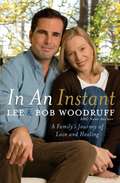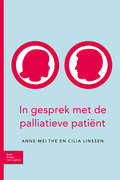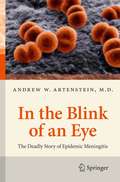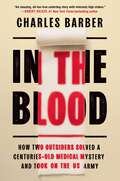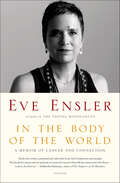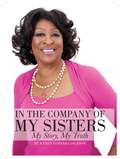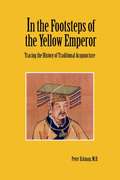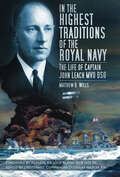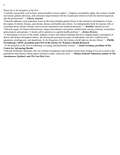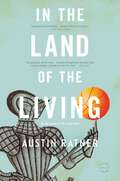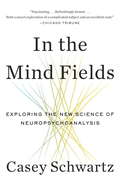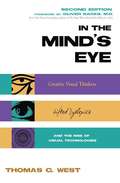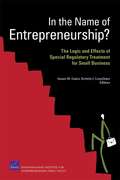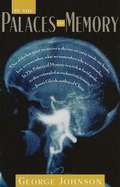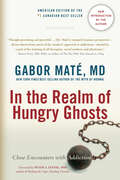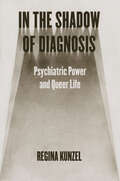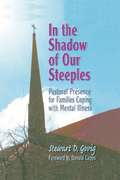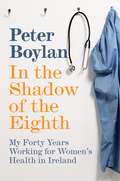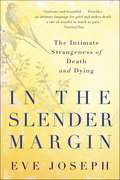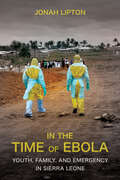- Table View
- List View
In Vivo Self-Assembly Nanotechnology for Biomedical Applications
by Hao Wang Li-Li LiThis book reviews and discusses the development of self-assembled nanomaterials applied in biomedical fields. Based on self-assembled nanomaterial constructions, it highlights the mechanisms of the stimuli-response-induced assembly/disassembly and transformation. Moreover, it examines healthcare-related diseases, the applications of nanomaterials and therapy/detection strategies, providing readers with both a deeper understanding of the subject and inspirations for future research. The book is primarily intended for researchers and graduate students in the fields of material sciences and chemistry who wish to learn about the principles, methods, mechanisms and biomedical applications of self-assembled nanomaterials.
In a Little Kingdom
by Perry StieglitzFirst Published in 1991. Routledge is an imprint of Taylor & Francis, an Informa company.
In an Instant: A Family's Journey of Love and Healing
by Lee Woodruff Bob WoodruffIn one of the most anticipated books of the year, Lee Woodruff, along with her husband, Bob Woodruff, share their never-before-told story of romance, resilience, and survival following the tragedy that transformed their lives and gripped a nation.In January 2006, the Woodruffs seemed to have it all-a happy marriage and four beautiful children. Lee was a public relations executive and Bob had just been named co-anchor of ABC's World News Tonight. Then, while Bob was embedded with the military in Iraq, an improvised explosive device went off near the tank he was riding in. He and his cameraman, Doug Vogt, were hit, and Bob suffered a traumatic brain injury that nearly killed him.In an Instant is the frank and compelling account of how Bob and Lee's lives came together, were blown apart, and then were miraculously put together again-and how they persevered, with grit but also with humor, through intense trauma and fear. Here are Lee's heartfelt memories of their courtship, their travels as Bob left a law practice behind and pursued his news career and Lee her freelance business, the glorious births of her children and the challenges of motherhood.Bob in turn recalls the moment he caught the journalism "bug" while covering Tiananmen Square for CBS News, his love of overseas assignments and his guilt about long separations from his family, and his pride at attaining the brass ring of television news-being chosen to fill the seat of the late Peter Jennings.And, for the first time, the Woodruffs reveal the agonizing details of Bob's terrible injuries and his remarkable recovery. We learn that Bob's return home was not an end to the journey but the first step into a future they have learned not to fear but to be grateful for.In an Instant is much more than the dual memoir of love and courage. It is an important, wise, and inspiring guide to coping with tragedy-and an extraordinary drama of marriage, family, war, and nation.A percentage of the proceeds from this book will be donated to the Bob Woodruff Family Fund for Traumatic Brain Injury.From the Hardcover edition.
In gesprek met de palliatieve patiënt
by Cilia Linssen A. M. TheIn het najaar van 2003 kwam het beroepscompetentie- en kwalificatieprofiel van de eerstverantwoordelijk verzorgende (EVV) tot stand. Dit profiel vormt de basis van de eerste branche-erkende opleiding voor verzorgenden, de EVV-opleiding. Het boek: De eerstverantwoordelijk verzorgende geeft een theoretische basis aan alle verzorgenden die als EVV of zorgcoördinator (gaan) werken. Het boek informeert u over de dertien beroepscompetenties van de EVV en is door deze volledigheid uniek in zijn soort. Thema's die behandeld worden zijn: de zorgvrager centraalmethodisch werkencoördinatie en continuïteit van zorgkwaliteitszorg en professionaliseringwonen en leven in een groep
In the Blink of an Eye
by Andrew W. ArtensteinThis book is an account of a major historical event, in the world of medicine. As the son of one of the lead scientists who developed the vaccine for meningococcal meningitis, Andrew Artenstein has a unique perspective on the story. In the Blink of an Eye shares his experience.
In the Blood: How Two Outsiders Solved a Centuries-Old Medical Mystery and Took On the US Army
by Charles BarberThe "high-stakes" true story of how an absent-minded inventor and a down-on-his-luck salesman joined forces to create a once‑in‑a‑generation lifesaving product: "Suspenseful storytelling helps us see and feel the struggle and frustration, the sweat and tears . . . Inspiring&” (Robert Kolker, #1 New York Times bestselling author of Hidden Valley Road). At the 1993 Battle of Mogadishu, dramatized by the popular film Black Hawk Down, the majority of soldiers who died were killed instantly or bled to death before they could reach an operating table. This tragedy reinforced the need for a revolutionary treatment that could transform trauma medicine. So, when Frank Hursey and Bart Gullong—who had no medical or military experience—discovered that a cheap, crushed rock called zeolite had blood‑clotting properties, they brought it to the military's attention. The Marines and the Navy adopted the resulting product, QuikClot, immediately. The Army, however, resisted. It had two products of its own being developed to prevent excessive bleeds, one of which had already cost tens of millions of dollars. The other, "Factor Seven," had a more dangerous complication: its side effects could be deadly. Unwilling to let its efforts end in failure—and led by the highly influential surgeon Colonel John Holcomb—the Army set out to smear QuikClot&’s reputation. Over the course of six years, Hursey and Gullong engaged in an epic struggle with Holcomb for recognition. Ultimately, a whistle‑blower inside the Army challenged the Army&’s embrace of Factor Seven, which resulted in a massive lawsuit led by the U.S. Department of Justice. The lawsuit focused further attention on the financial ties between the pharmaceutical company that produced Factor Seven and Holcomb&’s research institute. By withholding QuikClot—which later became the medical miracle of the Iraq War—and in the use of Factor Seven with its known, life-threatening risks of heart attacks and strokes, the lives of countless soldiers were imperiled. Using deep reportage and riveting prose, In the Blood recounts this little‑known David‑and‑Goliath story of corruption, greed, and power within the military—and the devastating consequences of unchecked institutional arrogance.
In the Body of the World: A Memoir of Cancer and Connection
by Eve EnslerThe bestselling author of The Vagina Monologues shares her “extraordinarily riveting, graphic story of survival” (Publishers Weekly).In this extraordinary and evocative memoir, playwright, author, and activist V, formerly Eve Ensler, traces many paths of reconnection: with her body, after she is diagnosed with cancer; with the people of the world, in the face of injustice and abuse; and with the earth, victim of mass exploitation.Working in the Congo, V meets survivors of horrific rape and violence and sees firsthand how these women are creating hope and possibility out of horror. Just as she is about to help open a revolutionary leadership center called City of Joy, she is diagnosed with uterine cancer, resulting in months of difficult treatment. Through her experience, V is forced to become first and foremost a body—pricked, punctured, cut, scanned. As she recovers from her illness, V is able to let go of everything that doesn’t matter and find strength in what does.In the Body of the World is a haunting, revelatory work that calls on us to reestablish our connection to our bodies, to the world, and to those around us.Praise for In the Body of the World“Warm, funny, furious, and astute, as well as poetic, passionate, and heroic, Ensler harnesses all that she lost and learned to articulate a galvanizing vision of the essence of life: ‘The only salvation is kindness.’ . . . [A] scorching and enlightening memoir.” —Booklist (starred review)“A necessary book to read for its fierce, passionate commitment to making the world a safe place for women.” —The Boston Globe
In the Company of Grace: A Veterinarian's Memoir of Trauma and Healing
by Jody LulichThe son of a Black mother and white father overcomes family trauma to find the courage of compassion in veterinary practice Rising to accept a prestigious award, Jody Lulich wondered what to say. Explain how he&’d been attracted to veterinary medicine? Describe how caring for helpless, voiceless animals in his own shame and pain provided a lifeline, a chance to heal himself as well? Lulich tells his story in In the Company of Grace, a memoir about finding courage in compassion and strength in healing—and power in finally confronting the darkness of his youth.Lulich&’s white father and Black mother met at a civil rights rally, but love was no defense against their personal demons. His mother&’s suicide, in his presence when he was nine years old, and his sometimes brutal father&’s subsequent withdrawal set Lulich on a course from the South Side of Chicago to the Tuskegee School of Veterinary Medicine in Alabama to an endowed chair at the University of Minnesota, forever searching for the approval and affection that success could not deliver. Though shadowed by troubling secrets, his memoir also features scenes of surprising light and promise—of the neighbors who take him in, a brother&’s unlikely effort to save Christmas, his mother&’s memories of the family&’s charmed early days, bright moments (and many curious details) of veterinary practice. Most consequentially, at Tuskegee Lulich rents a room in the home of a seventy-five-year-old Black woman named Grace, whose wholehearted adoption of him—and her own stories of the Jim Crow era—finally gives him a sense of belonging and possibility.Completing his book amid the furor over George Floyd&’s murder, Lulich reflects on all the ways that race has shaped his life. In the Company of Grace is a moving testament to the power of compassion in the face of seemingly overwhelming circumstances.
In the Company of My Sisters: My Story, My Truth
by Karen Eubanks JacksonDance as though no one is watching you Love as though you have never been hurt Sing as though no one can hear you Live as though heaven is here on earth - Anonymous For millions of women, the words "You have breast cancer" are a harsh reality. For Black women, those words hit especially hard as the mortality rate for Black women is staggering. It's a battle Karen Eubanks Jackson knows all too well. A FOUR-time breast cancer survivor, Jackson has used her triumphs, tragedies and lessons learned to inspire others. Now, she’s sharing it all in this evocative new book, In the Company of My Sisters. First diagnosed in 1993, Jackson knew little about the disease, despite the fact that she’d had a relative die from breast cancer. It was, after all, a silent shame the family kept. Determined to educate herself, Jackson devoured herself in research. And when she couldn’t find information or support specifically for Black women, she set out to fill that void, creating Sisters Network Inc., the only national survivorship-run organization designed to increase local and national attention to the devastating impact that breast cancer has in the Black community. In the Company of My Sisters is Jackson’s story. Her truth in battling the disease for 27 years. How she survived. How she succeeded and built a national sisterhood of Black breast cancer survivors. How she hopes to continue inspiring and educating others along the way. The book is filled with personal experiences and observations from Jackson as well as other survivors, this book will give insight into what shaped Jackson into a woman able to beat breast cancer – again and again and again. And with all the valuable information Jackson has accumulated over the years, the book will also serve as a one-stop resource for all your breast cancer questions. For those battling breast cancer, those walking the journey with survivors, and those who just want to educate themselves, In the Company of My Sisters will inspire you by the beauty and strength of the human spirit and why Jackson has made it her life’s mission change the course of the narrative surrounding the disease and help Black women take action to beat breast cancer.
In the Footsteps of the Yellow Emperor
by Peter EckmanAcupuncture now enjoys immense popularity as a major form of alternative healing in the West. Once considered mysterious and exotic, acupuncture dates from before the first century BC and the Huang Di Nei Jing (The Yellow Emperor's Internal Classic), one of ancient China's earliest philosophical and medicinal texts. What makes it so popular today? How did the traditions of acupuncture evolve, migrate, and adapt to different societies worldwide?Originally published in 1996 to great acclaim, this updated paperback edition of In the Footsteps of the Yellow Emperor offers a fascinating and highly readable account of one doctor's personal and professional quest to explore the healing traditions of Asia, its rich historical lineage, and its subsequent transmission to contemporary Europe and North America. It is a must-have book in the healing arts for all practitioners and general-interest readers. Peter Eckman, MD, PhD (New York University), MAc (College of Traditional Acupuncture, Leamington Spa, England) is editor of The Essential Book of Traditional Chinese Medicine and co-author of Closing the Circle: Lectures on the Unity of Traditional Oriental Medicine. He has a medical practice in San Francisco.
In the Highest Traditions of the Royal Navy: The Life of Captain John Leach MVO DSO
by Matthew B WillsOn 10 December 1941, the Royal Navy battleship HMS Prince of Wales was sunk by Japanese bombers in the South China Sea. Amongst the several hundred men who went down with her was her Captain, John Leach, who had fought against frightful odds and to the very end made the best of an impossible situation with courage and calmness. He truly embodied ‘the highest traditions of the Royal Navy’. Author Matthew B. Wills analyses the influences that shaped John Leach and led him ultimately to his heroic end: his time at Royal Naval College Osborne and Britannia Royal Naval College Dartmouth and his baptism of fire when he survived a direct shell hit to the bridge where he was standing. He describes Leach’s role in command during the Battle of the Denmark Strait, during which the Prince of Wales inflicted damage on the Bismarck that contributed to her later destruction ? and then the ill-fated mission to Singapore as part of Force Z, an attempt to intercept Japanese landings in Malaya.
In the Kingdom of the Sick: A Social History of Chronic Illness in America
by Laurie EdwardsThirty years ago, Susan Sontag wrote, "Everyone who is born holds dual citizenship in the kingdom of the well and the kingdom of the sick ... Sooner or later each of us is obliged, at least for a spell, to identify ourselves as citizens of that other place." Now more than 133 million Americans live with chronic illness, accounting for nearly three-quarters of all health care dollars, and untold pain and disability. <p><p> There has been an alarming rise in illnesses that defy diagnosis through clinical tests or have no known cure. Millions of people, especially women, with illnesses such as irritable bowel syndrome, chronic pain, and chronic fatigue syndrome face skepticism from physicians and the public alike. And people with diseases as varied as cardiovascular disease, HIV, certain cancers, and type 2 diabetes have been accused of causing their preventable illnesses through their lifestyle choices. <p><p> We must balance our faith in medical technology with awareness of the limits of science, and confront our throwback beliefs that people who are sick have weaker character than those who are well. Through research and patient narratives, health writer Laurie Edwards explores patient rights, the role of social media in medical advocacy, the origins of our attitudes about chronic illness, and much more. What The Noonday Demon did for people suffering from depression, In the Kingdom of the Sick does for those who are chronically ill.
In the Land of the Living: A Novel
by Austin RatnerA dazzling story of fathers, sons, and brothers - bound by love, divided by history The Auberons are a lovably neurotic, infernally intelligent family who love and hate each other-and themselves-- in equal measure. Driven both by grief at his young mother's death and war with his distant, abusive immigrant father, patriarch Isidore almost attains the life of his dreams: he works his way through Harvard and then medical school; he marries a beautiful and even-keeled girl; in his father-in-law, he finds the father he always wanted; and he becomes a father himself. He has talent, but he also has rage, and happiness is not meant to be his for very long. Isidore's sons, Leo and Mack, haunted by the mythic, epic proportions of their father's heroics and the tragic events that marked their early lives, have alternately relied upon and disappointed one another since the day Mack was born. For Leo, who is angry at the world but angrier at himself, the burden of the past shapes his future: sexual awakening, first love, and restless attempts live up to his father's ideals. Just when Leo reaches a crossroads between potential self-destruction and new freedom, Mack invites him on a road trip from Los Angeles to Cleveland. As the brothers make their way east, and towards understanding, their battles and reconciliations illuminate the power of family to both destroy and empower-and the price and rewards of independence. Part family saga, part coming-of-age story, In the Land of the Living is a kinetic, fresh, bawdy yet earnest shot to the heart of a novel about coping with death, and figuring out how and why to live.
In the Mind Fields
by Casey Schwartz"Everywhere I looked it seemed that we were being defined by what our brains were doing . . . Everywhere, there were hucksters and geniuses, all trying to colonize the new world of the brain." "I'd never been a science person," Casey Schwartz declares at the beginning of her far-reaching quest to understand how we define ourselves. Nevertheless, in her early twenties, she was drawn to the possibilities and insights emerging on the frontiers of brain research. Over the next decade she set out to meet the neuroscientists and psychoanalysts engaged with such questions as, How do we perceive the world, make decisions, or remember our childhoods? Are we using the brain? Or the mind? To what extent is it both? Schwartz discovered that neuroscience and psychoanalysis are engaged in a conflict almost as old as the disciplines themselves. Many neuroscientists, if they think about psychoanalysis at all, view it as outdated, arbitrary, and subjective, while many psychoanalysts decry neuroscience as lacking the true texture of human experience. With passion and humor, Schwartz explores the surprising efforts to find common ground. Beginning among the tweedy Freudians of North London and proceeding to laboratories, consulting rooms, and hospital bedsides around the world, Schwartz introduces a cast of pioneering characters, from Mark Solms, a South African neuropsychoanalyst with an expertise in dreams, to David Silvers, a psychoanalyst practicing in New York, to Harry, a man who has lost his use of language in the wake of a stroke but who nevertheless benefits from Silvers's analytic technique. In the Mind Fields is a riveting view of the convictions, obsessions, and struggles of those who dedicate themselves to the effort to understand the mysteries of inner life.From the Hardcover edition.
In the Mind's Eye: Visual Thinkers, Gifted People with Dyslexia and Other Learning Disabilities, Computer Images and the Ironies of Creativity
by Thomas G. WestExposes myths about conventional intelligence by examining the role of visual-spatial strengths and verbal weaknesses in the lives of 11 gifted individuals, including Albert Einstein and Thomas Edison. Examines research in neuroscience that shows a link between visual talents and verbal difficulties, and discusses developments in computer technology that herald a shift toward the increased use of visual approaches in business and science. This revised edition offers an expanded list of national and international organizations, and an updated bibliography. Annotation c. by Book News, Inc., Portland, Or.
In the Name of Entrepreneurship?
by Susan M. Gates Kristin J. LeuschnerWhat are the differential effects of regulation and policy on small businesses? What is the impact of special regulatory treatment for small businesses? This book sheds light on these issues through analysis of the regulatory and public policy environment with regard to small businesses, including focused studies in four key areas: health insurance, workplace safety, corporate governance, and business organization.
In the Palaces of Memory: How We Build the Worlds Inside Our Heads
by George JohnsonEven as you read these words, a tiny portion of your brain is physically changing. New connections are being sprouted--a circuit that will create a jab of recognition if you encounter the words again. That is one of the theories of memory presented in this intriguing and splendidly readable book, which distills three researchers' inquiries into the processes that enable us to recognize a face that has aged ten years or remember a melody for decades.
In the Realm of Hungry Ghosts: Close Encounters with Addiction
by Peter A. Levine Gabor MateBased on Gabor Maté's two decades of experience as a medical doctor and his groundbreaking work with the severely addicted on Vancouver's skid row, In the Realm of Hungry Ghosts radically reenvisions this much misunderstood field by taking a holistic approach. Dr. Maté presents addiction not as a discrete phenomenon confined to an unfortunate or weak-willed few, but as a continuum that runs throughout (and perhaps underpins) our society; not a medical "condition" distinct from the lives it affects, rather the result of a complex interplay among personal history, emotional, and neurological development, brain chemistry, and the drugs (and behaviors) of addiction. Simplifying a wide array of brain and addiction research findings from around the globe, the book avoids glib self-help remedies, instead promoting a thorough and compassionate self-understanding as the first key to healing and wellness. In the Realm of Hungry Ghosts argues persuasively against contemporary health, social, and criminal justice policies toward addiction and those impacted by it. The mix of personal stories--including the author's candid discussion of his own "high-status" addictive tendencies--and science with positive solutions makes the book equally useful for lay readers and professionals.From the Trade Paperback edition.
In the Shadow of Diagnosis: Psychiatric Power and Queer Life
by Regina KunzelA look at the history of psychiatry’s foundational impact on the lives of queer and gender-variant people. In the mid-twentieth century, American psychiatrists proclaimed homosexuality a mental disorder, one that was treatable and amenable to cure. Drawing on a collection of previously unexamined case files from St. Elizabeths Hospital, In the Shadow of Diagnosis explores the encounter between psychiatry and queer and gender-variant people in the mid- to late-twentieth-century United States. It examines psychiatrists’ investments in understanding homosexuality as a dire psychiatric condition, a judgment that garnered them tremendous power and authority at a time that historians have characterized as psychiatry’s “golden age.” That stigmatizing diagnosis made a deep and lasting impact, too, on queer people, shaping gay life and politics in indelible ways. In the Shadow of Diagnosis helps us understand the adhesive and ongoing connection between queerness and sickness.
In the Shadow of Illness
by Myra Bluebond-LangnerWhat is it like to live with a child who has a chronic, life-threatening disease? What impact does the illness have on well siblings in the family? The author suggests that understanding the impact of the illness lies not in the identifying deficiencies in the lives of those affected, but in appreciating how family members carry on with their lives in the face of the disease's intrusion. She looks at how parents adjust their priorities and their idea of what constitutes a normal life, how they try to balance the needs of other family members while caring for the ill child, and how they see the future. Since the issues raised are not unique to cystic fibrosis but are common to other chronic and life-threatening illnesses, this book will be of interst to all who study, care for, or live with the seriously ill.
In the Shadow of Illness: Parents and Siblings of the Chronically Ill Child
by Myra Bluebond-LangnerWhat is it like to live with a child who has a chronic, life-threatening disease? What impact does the illness have on well siblings in the family? Myra Bluebond-Langner suggests that understanding the impact of the illness lies not in identifying deficiencies in the lives of those affected, but in appreciating how family members carry on with their lives in the face of the disease's intrusion. The Private Worlds of Dying Children, Bluebond-Langner's previous book, now considered a classic in the field, explored the world of terminally ill children. In her new book, she turns her attention to the lives of those who live in the shadow of chronic illness: the parents and well siblings of children who have cystic fibrosis. Through a series of narrative portraits, she draws us into the daily lives of nine families of children at different points in the natural history of the illness--from diagnosis through the terminal phase. In these portraits, as family members talk about their experiences in their own words, we see how parents, well siblings, and the ill children themselves struggle, in different ways, to contain the intrusion of the disease into their lives. Bluebond-Langner looks at how parents adjust their priorities and their idea of what constitutes a normal life, how they try to balance the needs of other family members while caring for the ill child, and how they see the future. This context helps us understand how well siblings view the illness and how they relate to their ill sibling and parents. Since the issues raised are not unique to cystic fibrosis but are common to other chronic and life-threatening illnesses, this book will be of interest to all who study, care for, or live with the seriously ill.
In the Shadow of Our Steeples: Pastoral Presence for Families Coping with Mental Illness
by Stewart D. Govig *Deceased*In the Shadow of Our Steeples: Pastoral Presence for Families Coping with Mental Illness helps you and other experts and quasi-experts in the field of religious and family counseling to give sound direction and guidance to family members who are caring for a loved one who suffers from mental illness. You'll find many avenues of care and counseling that will greatly enhance your ability to lend support and encouragement in situations where the burden of care seems too great for only a few individuals to lift. In reading it, you'll find your options increase tenfold, and you'll become a better symbol and resource of faith for these unique families.Inside In the Shadow of Our Steeples, you'll discover how to cure the obsession with success that too often goes along with counseling situations that involve mental illness. You'll also discover a greater, more enduring strain of Christian love, full of surprising joys, caring, and hope. Geared toward moving parishes away from public stigmas and toward a collective ministry of presence, this book beckons to those clergy who know and believe that a far more understanding and far-reaching form of counseling exists. Specifically, you'll learn about these and other long-sought-after aids: establishing theological foundations and goal-setting in the area of pastoral care countering the stigmas of mental illness using biblical studies and models using a “ministry of presence” to analyze chronic illness and promote “rehabilitation in the absence of cure” bringing clergy and mental health professionals into a collaborative arena of care improving the relationship of professional chaplains to clergy in ordinary parish settingsOverall, In the Shadow of Our Steeples helps bring together the sufferer, the family, the civil servant, and the religious counselor into one synergistic group of rehabilitative influence. This sound guide's specific examples and proven strategies will help turn your despair into hope, even in the face of chronic mental illness.
In the Shadow of the Eighth: My Forty Years Working for Women's Health in Ireland
by Peter BoylanIn over forty years in medicine - seven of these as Master of the National Maternity Hospital - obstetrician Peter Boylan was at the births of more than 6,000 babies. He saw women and families at their most vulnerable, their most joyous, and sometimes their most heart-broken.In the Shadow of the Eighth is the story of how a young doctor without strong views on abortion became convinced that women should be trusted to make the right decisions for their lives - and how he then did everything in his power to bring about a situation where they could.More than that, it is an engaging account of working in one of medicine's most satisfying specialities, a revealing behind-the-scenes insight into what it's like trying to make change happen, and a fascinating portrait of a society in transition.Lively, gripping, sometimes enraging but always compassionate, Peter Boylan's story is vital and encouraging reading for these turbulent times.'A comprehensive, insightful and often shocking social history of the country' Irish Independent'A hero to many (including me)' @MarianKeyes'Both personal and political ... a very important history of recent events that have utterly changed Ireland's social and political landscapes' Irish Times'A fascinating story' Matt Cooper, Today FM'The book is fabulous' Pat Kenny, Newstalk
In the Slender Margin: The Intimate Strangeness of Death and Dying
by Eve JosephLike Joan Didion's The Year of Magical Thinking, an extraordinarily moving and engaging look at loss and death. Eve Joseph is an award-winning poet who worked for twenty years as a palliative care counselor in a hospice. When she was a young girl, she lost a much older brother, and her experience as a grown woman helping others face death, dying, and grief opens the path for her to recollect and understand his loss in a way she could not as a child. In the Slender Margin is an insider's look at an experience that awaits us all, and that is at once deeply fascinating, frightening, and in modern society shunned. The book is an intimate invitation to consider death and our response to it without fear or morbidity, but rather with wonder and a curious mind. Writing with a poet's precise language and in short meditative chapters leavened with insight, warmth, and occasional humor, Joseph cites her hospice experience as well as the writings of others across generations—from the realms of mythology, psychology, science, religion, history, and literature—to illuminate the many facets of dying and death. Offering examples from cultural traditions, practices, and beliefs from around the world, her book is at once an exploration of the unknowable and a very humane journey through the land of grief.
In the Time of Ebola: Youth, Family, and Emergency in Sierra Leone
by Jonah LiptonThe anthropologist Jonah Lipton was in Freetown, Sierra Leone, when the largest Ebola outbreak in history hit. In the Time of Ebola is his account of the epidemic, centering on the residents of a neighborhood swept up in the emergency.Lipton follows the lives of young men and women over a period of seven years, revealing what the epidemic looked like on the ground. He explores its causes, impacts, and legacies in a place where crisis might be considered the norm, not the exception. The emergency was disruptive and challenging, not least due to the short-term international response. Yet for many youths Ebola was a time of unusual clarity on the ambiguities around care, work, and coming of age experienced in a context of vast economic and social inequalities. Lipton shows how residents of this historically cosmopolitan West African city drew on centuries-old frameworks for managing foreign intervention. In the Time of Ebola questions dominant framings of crisis and offers ways of theorizing, researching, and responding to emergencies that make the home, the family, and "ordinary life" their starting point.
